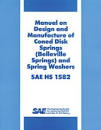Descrição
Coned disk springs, also known as Belleville Springs, have a long history. In 1835, one Timothy Hackworth, in England, received acknowledgment for an application in a safety valve. A Frenchman, Julian F.Belleville, secured a British patent in the 1860’s for a particular application. AT that time, these springs were mainly used in the buffer parts of railway rolling stock and for recoil mechanisms of guns, etc.Whenever space is limited, particularly in the presence of high forces, the use of coned disk springs will be of advantage. Linear, regressive, and even progressive load-deflection characteristics can be obtained by varying the basic dimensions or by stacking. A large number of standard of-the-shelf sizes is available, so that custom sizes may not be required. For these reasons, coned disk springs are used today in virtually all branches of engineering with new applications surfacing all the time. This spring manual takes a detailed look at design considerations, design stresses, materials and finishes, manufacturing and tolerances, modified disk spring shapes, spring washers, and design examples. This manual is the latest edition in the group of spring manuals currently under the review of the SAE Spring Committee. The preceding SAE manuals on coned disk springs were published in 1950 (First edition), and 1955 (Second Edition). Developments during the past 30 years necessitated a complete revision. In addition to updating the treatment of coned Disk springs, material on other spring washers, not directly related to the coned Disk Spring, has been added. In accordance with current sAE practice, customary units have been replaced by metric SI units throughout this manual; for a conversion table see the Appendix.
- Publisher : Society of Automotive Engineers (1 Jun. 1999)
- ISBN-10 : 0898834244
- ISBN-13 : 9780898834246
- Obs.: Livro sem uso, com paginas amareladas e um pouco sujas pelo tempo – capa, contracapa, bordas e paginas integras. sem marcas, grifos, marcações ou qualquer tipo de detalhe que possa interferir na leitura ou pesquisa – Conteudo perfeito




